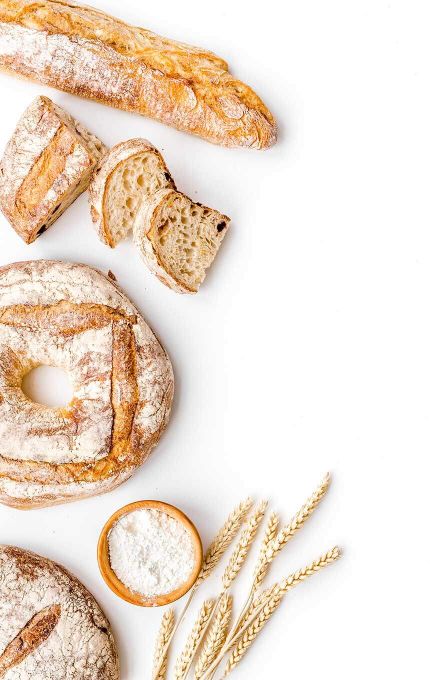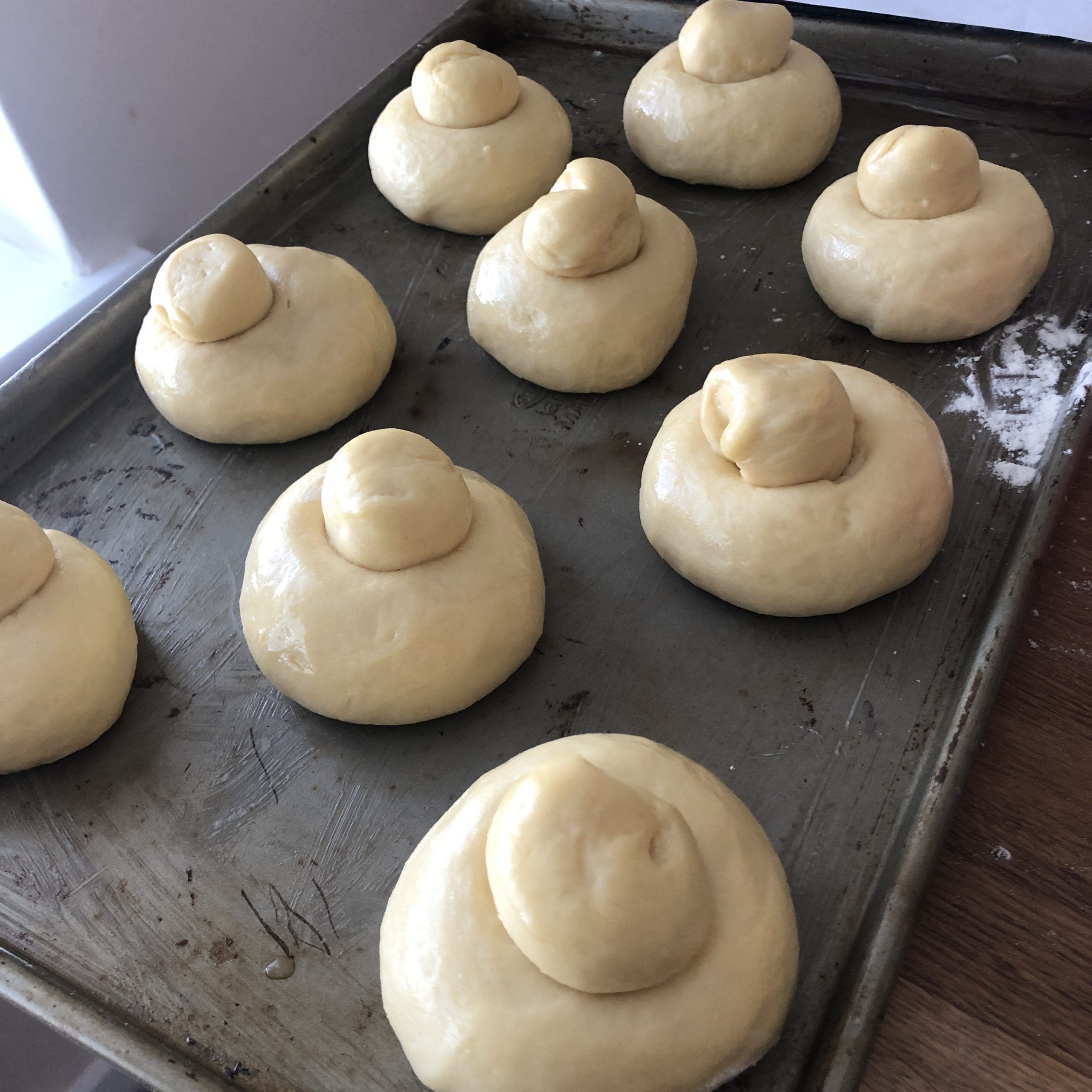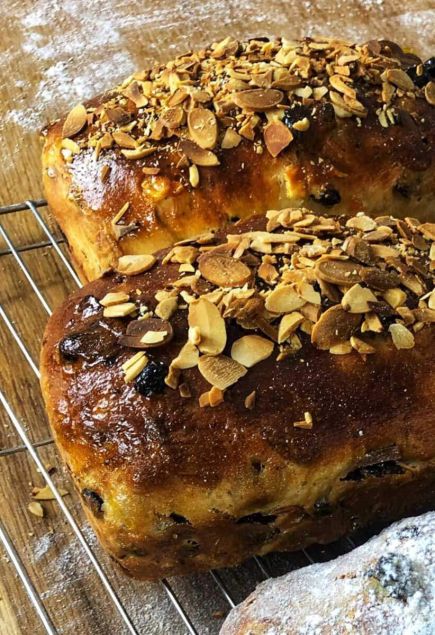Warning: Array to string conversion in /home/busbysbakery/public_html/wp-content/plugins/wp-schema-pro/classes/class-bsf-aiosrs-pro-markup.php on line 308
Nutritional information per brioche
Calories: 234kcal | Carbohydrates: 26g | Protein: 5g | Fat: 13g | Saturated Fat: 7g | Fiber: 1g | Sugar: 6g | Calcium: 27mg | Iron: 2mg
Brioscia Siciliano | A Soft Italian Brioche Recipe
Brioche is one of the most recognised and celebrated bread in the world and Brioscia Siciliano is my preferred version. Packed with flavour, this Italian brioche is lighter and softer than authentic French brioche. There are quite a few techniques that are used to make brioche, one of the most challenging is shaping brioche à tête.


Nutritional information per brioche
Calories: 234kcal | Carbohydrates: 26g | Protein: 5g | Fat: 13g | Saturated Fat: 7g | Fiber: 1g | Sugar: 6g | Calcium: 27mg | Iron: 2mg

Ingredients for 20 Servings:
For the dough:
- 500g White bread flour
- 200g Milk
- 250g Eggs (5 medium)
- 25g Fresh yeast (12g active dried)
- 8g Salt
- 80g Caster sugar
- 250g Salted butter (at room temperature)
You can use unsalted butter for this brioche recipe, just increase the salt to 10g.
For baking:
- 1 egg and a pinch of salt for the egg wash
- A tablespoon of butter for greasing.
For the sugar glaze:
- 2 tablespoons of caster sugar
- A cup of hot water
Yeast conversion tips
When making bread with high amounts of sugar in the recipe, try osmotolerant yeast. This type of yeast thrives in high sugar environments where common yeasts often struggle. That said, I used fresh yeast in this recipe and it works great!
If using instant yeast, divide the amount of fresh yeast used by 3 and follow the same method as the recipe. Active dried yeast needs to be activated before use. In this case, warm the milk and water using 10 second bursts in the microwave until it reaches 35C (95F) – no higher. Add the dried yeast and a teaspoon of sugar to the milk, whisk and leave for 10 minutes to bloom. Add the yeasty milk to the recipe when required.
Changing the size of the recipe
This recipe makes 20 brioches, however, you can place 3 in a tin to make a loaf. If you want to change the size of the recipe, use the bakers formula.
Total Recipe Time
-
Preparation Time16:00
-
Cooking Time0.15
Goes Great with
Fantastic fun, and absolutely delicious! Give this a go – you’ll love it! This bread is fantastic eaten with ice cream as done in the isle of Sicily. This recipe makes 20 small brioche à têtes’ and should take around 16 hours as the dough is kept in the refrigerator overnight.
These Italian versions are a little more forgiving if the shaping isn’t perfect than the original French brioche. If you don’t fancy the traditional brioche à tête shape, they can simply be rounded to make the most delicious brioche rolls or turn them into loaves.
What you need to make brioscia siciliano
To make this amazing sourdough bread, you’ll need the following equipment:
- Brioche à tête moulds or a heavy-duty baking sheet lined with baking paper
- Mixing bowls
- A metal and plastic dough scraper
- A lid or some plastic wrap (something to cover the bowl)
- Scales, if you don’t have a decent set you might want to try these scales from Myweigh
- A baking stone
Using a thermometer will help you with controlling proofing times. For accurate dough temperature readings try this thermometer from Gdealer. Aim for dough temperature between 25C and 30C (77-86F).
What if I don’t have a baking stone?
A baking stone conducts heat into the loaf. Using one increases the height of the oven spring and helps to give an even bake on the base of the loaf. If you don’t have a baking stone, preheat the thickest baking sheet that you have.
Can I use a Dutch oven to make this recipe?
There is no need to use a Dutch oven to make this brioche recipe as we don’t need steam in the oven. Just baking on the shelf in the convection oven.

Step-By-Step Method For This Recipe
1) Weigh up
First, weigh all the ingredients and dice the butter into cubes. If using dried yeast follow the instructions below.
2) Start kneading
Add the ingredients (minus the butter) to a large mixing bowl and set a 6-minute timer. With a plastic dough scraper, make sweeping circular movements through the ingredients to combine them in the bowl. Once the dough forms a mass, knead slowly on a table, using a slow, stretching motion. Continue this until the timer beeps. At this point, the dough will have an even consistency. Scrape the dough back into the mixing bowl, cover with a bag and place it in the fridge for 25 minutes.
Using a dough mixer:
Alternatively you can use a dough mixer. Excluding the butter, add the ingredients to a dough mixer, fitted with a dough hook attachment. Mix on slow speed for 5 minutes, then increase the speed and mix for a further 8 minutes. Slow down the mixer and add the butter, a few cubes at a time. Continue mixing for another 5 minutes, or until the butter is incorporated and nice, luscious, gluten strands are visible in the dough. Skip to step 5.
3) Fast knead & add the butter
Take the dough out of the fridge and onto a worktop. Set a 5-minute timer and use a stretch, slap and fold technique until the timer beeps. Add the butter all at once and keep kneading for an extra two minutes. Don’t worry if it doesn’t get fully incorporated. Cover, and place back in the fridge for another 20 minutes.
4) Knead again
Remove from the fridge again, and knead on the table using a fast technique until the butter is incorporated and nice, luscious, gluten strands are visible in the dough. This can take up to 8 minutes.
5) Bulk ferment overnight
Place back in the bowl, cover with a bag or plastic wrap and keep in the fridge for 12-14 hours.
Brioche is a sticky dough which is why it has to go into the fridge to cool. It warms up quickly too so work fast when dividing and shaping your rolls.
6) Divide into dough pieces
The next day, take the dough out of the fridge and remove it from the bowl to a floured table. Using a metal dough scraper, and a set of scales, divide the dough into 70g pieces and roughly preshape into balls.
7) Prepare the tray
Leave to rest for 10 minutes on the table whilst greasing a baking sheet with butter or lining it with greaseproof paper.
8) Shape into the brioche à tête shape
To make into brioche à tête, roll the balls into a sausage shape, and leave to rest for 1 minute. Next roll into a sausage again, and turn the dough into a ring with an end overhanging. Push the overhang through the hole in the ring to make the brioche à tête shape. Place onto the baking sheet.
Shape the round balls and place into a greased tin to make some lovely soft brioche loaves. Alternatively tray the balls on a lined baking sheet and bake as brioche rolls.
9) Egg wash
Break an egg, add a pinch of salt and whisk. Use a pastry brush to brush the egg wash over the shaped brioche.

10) Final rise
Leave to rise for around 3 hours. This will depend on the temperature of the room. Test with the poke test to check if they’re ready. Preheat the oven to 180C (355F).
11) Egg wash and bake
Again, egg wash the brioche, before baking in the oven for 15-20 minutes. It is best to take them out just before a golden colour is achieved as they continue to brown when they cool.
12) Glaze and cool
Once baked, allow to cool on a wire rack. Mix the sugar and a couple of drops of boiling water in a cup to dissolve the sugar. Add the glaze over the Italian brioches for a nice shiny surface.
More Delicious Ideas for You
Keep up to date with the latest Articles, Recipes & Bread Baking info by joining my mailing list
Join The Weekly Bread Baker's Newsletter!
Latest Articles
Baking Categories
Disclaimer
Address
8 Woodland Avenue,
Worthing
West Sussex
BN13 3AF
UK







